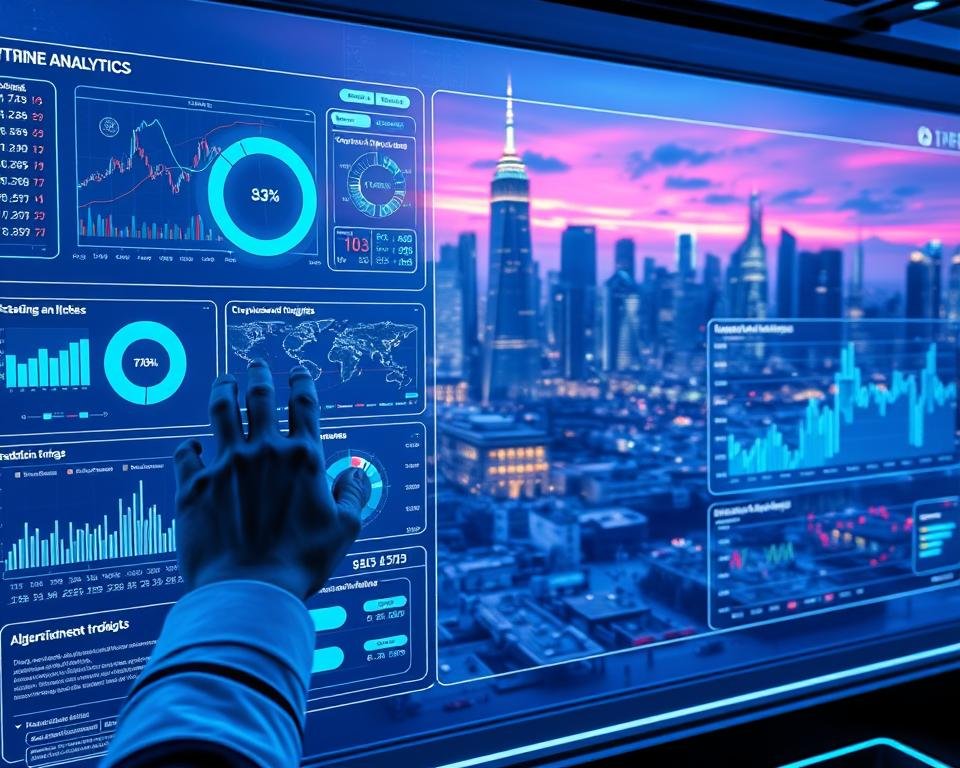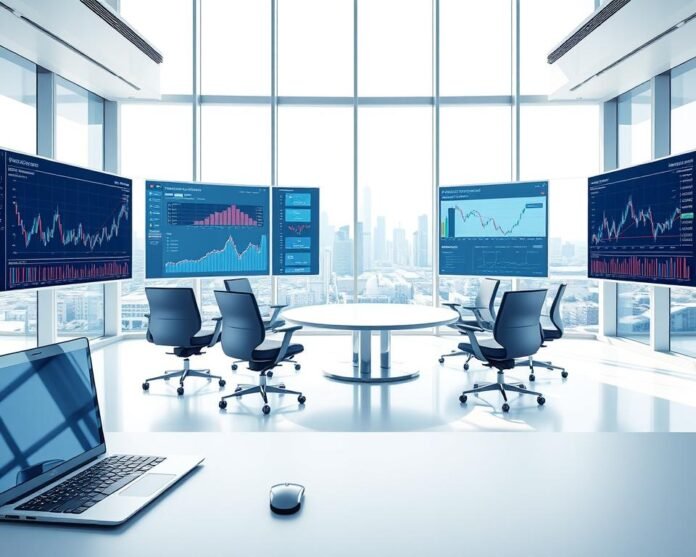Big Data and AI in Trading: Revolutionizing the Financial Markets in 2025
The financial world is changing fast. This is because of the growing amount and complexity of financial data. Now, making decisions in financial markets is getting more complex.
AI-driven techniques are making trading analytics better. They help make smarter choices. AI analyzes lots of data to help traders make informed decisions.
Big Data Analysis is key in trading. It gives insights that help businesses succeed.
Key Takeaways
- AI is transforming the financial sector by making decisions better.
- Trading analytics is getting smarter thanks to AI.
- AI helps traders make informed choices.
- Big Data Analysis is vital for business success in trading.
- AI is changing the financial world.
Understanding Big Data in the Financial Sector
Big data has changed how traders look at and predict market trends. It’s a huge amount of information from many places, like customer interactions and market trends. This data is key for making trading plans and decisions.
What Constitutes Big Data?
Big data in finance is all about volume, variety, and speed. It comes from many sources, like customer engagement metrics, sales transactions, and market data feeds. The data types are wide-ranging, from financial statements to social media and news.
Application in Trading
Big data helps traders in many ways. It lets them understand market trends better, guess future moves, and make data-driven trading decisions. With big data analytics, traders can see market feelings, spot patterns, and improve their strategies.
The Role of Artificial Intelligence
AI is changing the financial world by improving trading strategies and decision-making. Artificial Intelligence (AI) is a big step forward in computer science. It lets machines do things that humans usually do, like analyzing data and making predictions.
AI can do many things in trading. With AI trading strategies, traders can look at lots of data fast and find trends that others miss.
What Is Artificial Intelligence?
Artificial Intelligence means making computers that can do things that humans do. This includes learning, solving problems, and making decisions. In trading, AI helps by looking at market data, guessing price changes, and making smart choices.
AI gets better over time by learning from data. This makes it great for the fast-changing world of finance.
AI’s Importance in Trading
AI is very important in trading. With machine learning in finance, traders can stay ahead. AI looks at lots of data to find good trading chances.
AI also helps manage risk by spotting market drops and suggesting ways to avoid big losses. AI is making trading better and is now a key part of the financial world.
In short, AI is changing trading by giving traders better tools for analyzing data and making choices. As finance keeps growing, AI’s role in trading will only get bigger.
Combining Big Data and AI in Trading
The mix of Big Data and Artificial Intelligence (AI) is changing trading. Traders now use lots of data and smart AI to make better choices. They can guess market trends and improve their strategies.
The Synergy Between Big Data and AI
Big Data and AI together are very powerful. Big Data gives the base – lots of financial info like prices and volumes. AI then digs into this data to spot patterns and predict trends.
AI gets smarter over time by learning from data. This means it can suggest better trading plans. This team-up is key to algorithmic trading and quantitative trading with AI, helping traders stay ahead.
Case Studies in Trading Success
Many examples show how Big Data and AI work well together in trading. Hedge funds using AI have seen big gains, beating old ways of investing.
For example, AI is used to check social media and news to guess stock prices. This helps traders make quicker, smarter choices.
Benefits of Big Data Analysis in Trading
Big Data has changed the game for traders. Now, they can make better choices, guess market trends more right, and handle risks better. Big Data analysis in trading has opened new ways for traders to get ahead.

Improved Decision-Making
Big Data analysis helps traders make more informed decisions. It gives them lots of market data, news, and what people are saying on social media. This info helps spot trends and patterns that old ways can’t see.
By using predictive analytics for trading, traders can look at past data and guess future market moves. This lets them tweak their strategies and stay one step ahead.
Enhanced Market Predictions
Big Data has made market predictions better. By looking at big datasets, traders find patterns and trends to guess market moves better.
Trading analytics is key here. It helps traders dig into complex data and understand market trends. This info helps make smarter investment choices and boosts trading success.
Risk Management Strategies
Big Data analysis also helps traders manage risks better. By looking at market data and spotting risks, traders can lessen those risks and cut down losses.
Using predictive analytics for trading lets traders see when markets might drop. They can then adjust their plans to avoid big losses. This improves their trading results.
Challenges in Big Data Analysis for Trading
Big Data Analysis in trading has many benefits, but it also faces challenges. The financial world relies more on data-driven trading strategies. This has highlighted issues that need to be solved to fully use Big Data.
One big problem is the quality and accuracy of the data. Bad data can lead to wrong analysis and poor trading choices.
Data Quality and Integrity
It’s key to have good financial data. This means using strong data checks to find and fix errors. Also, the data must be right for the analysis being done.
Data cleansing is a big part of this. It’s about fixing wrong or missing data. Keeping data safe and secure is also important to avoid tampering or loss.
Technical Limitations
There are also technical hurdles. Handling big datasets needs lots of computer power and special software.
Traders need to get advanced financial data analysis tools. These tools must be able to handle Big Data’s size and complexity. Also, fitting these tools into current systems can be hard and needs a lot of tech know-how.
Overcoming these challenges is key for traders to use Big Data well. By improving data quality and dealing with tech issues, traders can make better choices.
Tools and Technologies for Big Data Analysis
Advanced tools and technologies are key for Big Data analysis. They help traders make smart choices. The financial sector’s huge data needs sophisticated tools for analysis.
Essential Software Solutions
Many software solutions lead in Big Data analysis for trading.
– Apache Hadoop is known for handling big data across many computers.
– Apache Spark is great for quick data processing, perfect for real-time analytics.
– Python libraries like Pandas and NumPy are used for data work and analysis.
These tools are essential for working with huge datasets. They help with AI trading strategies and better market predictions.
Cloud-Based Platforms
Cloud-based platforms have changed Big Data processing and analysis.
– Amazon Web Services (AWS) has a wide range of services for Big Data analysis, including storage and computing.
– Google Cloud Platform (GCP) offers a strong infrastructure for data analysis, using machine learning.
– Microsoft Azure is another big cloud platform for Big Data analytics, with various services.
These platforms let traders grow their data analysis, supporting machine learning in finance for better predictions.
Machine Learning Techniques in Trading
Machine learning has changed trading by using advanced algorithms. These algorithms find patterns in data that were hard to see before. This has made trading more accurate and helped traders make better choices.
Types of Machine Learning Algorithms
There are many types of machine learning algorithms for trading. Supervised learning algorithms are trained on labeled data to predict outcomes. For example, linear regression and decision trees help forecast stock prices and find trading chances.
Supervised vs. Unsupervised Learning
Supervised and unsupervised learning differ in how they use data. Supervised learning uses labeled data to learn how inputs relate to outputs. Unsupervised learning finds patterns in data without labels. Clustering algorithms, like k-means, group similar stocks or assets based on their features.
Real-Time Data Analysis
Markets move fast, making real-time data analysis key. Traders need to quickly analyze and act on market changes to stay ahead.
The Importance of Timeliness
Real-time data analysis is vital. It lets traders make informed decisions with the latest market data. This is critical for capitalizing on emerging trends and avoiding losses.
Being able to analyze data as it happens helps traders quickly respond to market shifts. This is very useful in unstable market times.
Tools for Real-Time Analysis
Many tools help with real-time data analysis. These include advanced software and cloud-based platforms. They quickly process lots of data, giving traders the insights they need.
Important tools include predictive analytics software and quantitative trading platforms. These use AI and machine learning to analyze data.
Using these tools, traders can better analyze market data in real-time. This improves their trading strategies and results. Real-time data analysis is a big step forward in trading, giving traders an edge in fast markets.
Data Visualization in Trading
In trading, data visualization is key to understanding complex data. Traders face huge amounts of data every day. Being able to see this data clearly is a big plus.
Effective data visualization helps traders spot trends and patterns quickly. It makes informed decision-making easier. Visualization tools make it simple to see important points without getting lost in details.
Why Visualization Matters
Data visualization is important because it makes complex data easier to understand. Traders use charts, graphs, and heat maps to get a better grasp of the market. This helps them make more accurate predictions and informed decisions.
Visualization also helps find connections between different market factors. This is key for creating effective trading strategies. With the right tools, traders can find insights in large datasets that might be hard to see by hand.
Best Practices for Effective Visualization
To get the most out of data visualization, follow some key practices. First, keep it simple and easy to understand. Don’t overload charts with too much info, as it can confuse.
Next, pick the right visualization for your data. For example, use line charts for time-series data and bar charts for categorical data. The right choice makes your data more insightful.
Lastly, use interactive tools for real-time data exploration. These tools let traders dive deep into data, try different scenarios, and adjust strategies. By following these tips, traders can fully use data visualization in their trading analytics and financial data analysis.
Impact on Algorithmic Trading
The use of Artificial Intelligence (AI) in algorithmic trading has changed the financial world. Algorithmic trading uses computer programs to buy and sell financial items automatically. AI lets these programs analyze huge amounts of data, predict outcomes, and make trades faster than humans.
Definition and Significance
Algorithmic trading uses algorithms to decide when and how to trade. It’s important because it can handle lots of data fast and accurately. AI makes it even better with machine learning and predictive analytics, helping traders get better results.
Examples of AI-Driven Algorithms
AI algorithms are used in trading for many things, like predicting the market and managing risks. For example, machine learning algorithms learn from past data to forecast future market trends. There are also NLP algorithms that read news and social media to understand market feelings. These AI tools are making AI trading strategies smarter and more flexible.
AI in algorithmic trading does more than just predict and analyze. It can also find the best trades and cut down on losses. As AI gets better, its role in trading will expand, leading to more advanced and effective systems.
Regulatory Considerations in Big Data Trading
Big Data is now key in trading, and rules are becoming more important. Advanced financial data analysis has changed trading, bringing both benefits and hurdles.
Big Data in trading brings big compliance challenges. Traders must follow complex rules to make sure their data-driven trading is legal. This includes following data protection laws and rules about financial deals.
Compliance Challenges
Keeping financial data safe and accurate is a big challenge. With so much data, the risk of breaches and cyber-attacks grows. Traders need strong security to guard against these threats.
Also, Big Data changes fast, and rules must keep up. This makes it hard for traders to keep up with new laws.
Ethical Implications
Big Data in trading also brings up ethical questions. The power of data-driven insights to shape markets and affect others is a concern. Traders must act ethically and follow the rules.
Using financial data analysis ethically means being open and fair. Traders should think about how their actions affect the market. They should aim to keep things fair for everyone.
In summary, Big Data trading faces many rules and ethics issues. By tackling these, traders can practice data-driven trading responsibly.
Future Trends in Big Data and AI Trading
The future of trading is changing fast thanks to Big Data and Artificial Intelligence. These technologies are getting better, leading to big changes in how we trade. Predictive analytics and automated trading are two areas that will see a lot of new things.

Predictive Analytics Innovations
Predictive analytics is getting smarter with Big Data and AI. Machine learning algorithms are now analyzing huge amounts of data. They find patterns and predict market trends. This helps traders make better choices.
New things are happening in predictive analytics too. AI is now used for sentiment analysis. It looks at news and social media to understand what people think about the market.
The Rise of Automated Trading
Quantitative trading with AI is also on the rise. Automated trading systems, powered by AI, can trade faster and more often than humans. They can handle lots of data quickly and make decisions without us.
The rise of automated trading is changing trading. It makes trading faster and opens up new chances for traders. They can use AI to create smart trading strategies.
As Big Data and AI keep getting better, we’ll see even more new things in trading. The future of Big Data and AI trading will make the industry more efficient, clear, and open to everyone.
How to Get Started with Big Data Analysis in Trading
Starting with Big Data Analysis in Trading with Artificial Intelligence might seem hard. But, breaking it down into smaller steps makes it easier. Traders need to know the tools and technologies first.
Practical Steps for Beginners
First, get to know the key software and cloud platforms for Big Data analysis. Then, learn about machine learning and its use in trading. Understanding data quality is also key for making smart trading choices.
Resources for Ongoing Education
For more knowledge, check out online courses on Coursera and edX. They cover Big Data Analysis and AI. Also, read reports from McKinsey and Deloitte for the latest on trading analytics.




